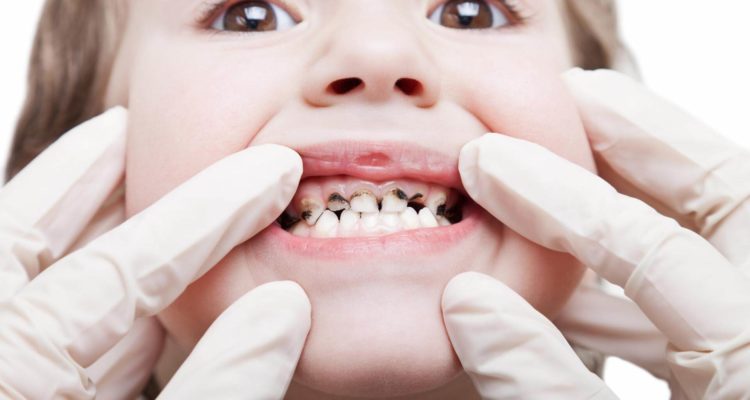
Why do teeth turn black and what to do about it
0
Without a dentist with a problem, most likely that's all, you can't handle it.
Let's note right away: blackened teeth are not the norm. A healthy smile can be white. Or yellowish – if dentin shows through from under the enamel, which has thinned with age. But dark gray and even more so black areas that you cannot get rid of with the help of a regular toothbrush and toothpaste are a clear reason for a trip to the dentist.
So that you know what to expect from this visit, we collected the most common causes of blackened teeth. And they found out what needs to be done in each case.
Why do adults' teeth turn black
Sometimes it is easy to fix the situation, but there are also complications.
Caries
Carious cavities can be of different colors – yellow-brown, gray and even black. Sometimes they occur inside the tooth without its visible destruction. In this case, the hole will shine even through the layer of enamel, giving the surface a steel shade.
What to do
Treat caries. How long it will take depends on how far the destructive process has gone.
Perhaps the dentist will simply treat the carious cavity and close it with a filling. But if the inner part of the tooth (pulp) is affected, root canal treatment will be required. Or maybe the tooth will have to be removed altogether, replacing it with a bridge, prosthesis or implant.
Water with high iron content
Usually the plaque has a yellowish tint, but in some cases more like black spots.
Researchers suggest that this may be due to excess iron in saliva. Yes, black plaque is more common in people who regularly drink water with a high concentration of this metal.
What to do
Most likely, you will need a professional brushing teeth And maybe their bleaching. In the future, the dentist will recommend brushing your teeth more thoroughly to avoid the appearance of plaque. And also, if possible, refuse to drink water with a high iron content.
Food that stains enamel
Classic examples of such products are mulberries, blueberries, beets, canned cherries. Formally, they do not paint the enamel itself, but again the coating on it – it has a porous structure and easily absorbs pigments from food. But everything looks as if the teeth themselves have turned black.
What to do
“Product” discoloration is unstable. Usually, to restore the white color of the teeth, it is enough to clean them thoroughly and rinse the mouth.
Pigmented oral care products
These can be pastes or rinses. For example, containing coal. The smallest black particles of such products can stain the plaque and thus change the color of the teeth.
What to do
Abandon such products. Or at least rinse your mouth more thoroughly after using them.
Bio supplements with iron
On the one hand, they increase its content in saliva, that is, they can also affect the formation of black dental plaque. On the other hand, the connection between the intake of bio-additives and the appearance of dark spots on the enamel has not yet been traced. But just keep this possibility in mind.
What to do
Be sure to tell your dentist that you are taking iron-containing drugs. The doctor will either note this version of the darkening of the teeth, or give recommendations that will stop the color changes. And a specialist will perform a professional cleaning.
Problems with digestion
The risk of black plaque formation also increases in people whose saliva has a high pH factor. That is, it has high acidity. This may be associated with some gastrointestinal diseases, such as gastroesophageal reflux (GERD).
What to do
The dentist will help remove the black plaque. And then he will recommend to consult a gastroenterologist to rule out possible disturbances in the work of the gastrointestinal tract.
Smoking
The teeth of smokers most often have a characteristic yellow-brown pigmentation. But in some cases, with constant smoking, the plaque can be black.
What to do
Professional cleaning and probably bleaching will be required to restore a healthy color. And it would also be useful to quit smoking. Or at least reduce the daily number of cigarettes.
Crowns or fillings with silver sulfide
They can also give tooth enamel a steel tint. But indirectly.
Metal crowns are considered obsolete. In modern dental clinics, ceramic or zirconium dioxide options have long been installed instead. But perhaps the person has an old model that was installed many years ago.
What to do
Ideally, the metal crown should be replaced. And not only because it “blackens” the teeth.
Such crowns, despite the presence of seemingly disinfecting silver, are simply dangerous: they contain mercury.
In addition, a carious process often begins under a metal filling – dentists call it secondary caries. Therefore, in any case, the tooth under the crown should be checked and, most likely, treated.
Genetics
There are certain hereditary diseases that can affect color. For example, imperfect dentinogenesis. It disrupts the formation of enamel. Because of this development abnormality, the teeth may have a yellow-brown or gray color with a bluish tint.
What to do
To begin with, make an accurate diagnosis. This can only be done by a qualified dentist. He will prescribe treatment. Therapy will depend on the patient's age, severity of dental problems and complaints.
The specialist will offer professional whitening or other procedures. For example, bonding: the dentist will apply a white composite material to the tooth, and then strengthen the structure with a special lamp for polymerization. You can also hide discoloration by installing veneers or crowns.
Tooth injury
Due to a strong impact, the blood vessels inside the pulp can burst. The hematoma that has formed if it is large will shine through the dentin and enamel.
What to do
Bleach and intensive cleaning will not help here.
It is dangerous to leave the damage without attention in the hope that it will heal. Hematoma can really disappear. But such an injury has serious consequences. For example, root resorption (resorption) of a tooth. And ankylosis is the further overgrowth of the root with bone, which will inevitably lead to tooth loss in the future.
Poor endodontic treatment
If the root canals were treated by a less than professional specialist, they may darken. And, shining through the enamel, give a gray-black shade to the entire tooth.
What to do
Previously, in such situations, a crown of the “correct” white color was simply installed. But modern dentistry offers an alternative.
If the tooth has turned black due to illiterate endodontic treatment, i.e. root canal treatment, then there is a way out in this situation – this is intracanal whitening. The tooth immediately lightens almost to its native shade.
Why children's teeth turn black
The reasons are, as a rule, the same as in adults. With the correction that babies are unlikely to have metal crowns with silver sulfide, and smoking is irrelevant.
But there are specific reasons that you need to be aware of.
Caries
Children's dentist Karina Tultseva says that carious cavities develop much faster in children than in adults.
What to do
At the first suspicion of caries, contact a dentist children's dentist. If the pathological process is caught at an early stage, the milk tooth can be easily cured.
Black plaque
Black spots occur much more often in children with age-related features related to the composition of bacteria in the oral cavity, and again age-related imperfection of the digestive system.
What to do
To remove the black plaque, the dentist will perform a professional cleaning. Often this is the only way out, since it is unlikely to be possible to remove black plaque at home.
This cleaning can be done once every three months, if the situation requires it.
With age, the bacterial composition in the cavity the mouth, as a rule, normalizes, and after the next cleaning, the plaque no longer makes itself felt.
Taking antibiotics by the mother during pregnancy or breastfeeding
In particular, drugs of the tetracycline series can have this effect.
The black horizontal band across the entire tooth row is tetracycline teeth , i.e. congenital blackness.
Color changes can appear on milk teeth and disappear with the appearance of permanent ones. But sometimes the blackness persists even in adulthood.
What to do
Treatment depends on how pronounced the color changes are and what condition the teeth are in.< /p>
Somewhere we can get by with cleaning, polishing and home remineralizing therapy. But mainly it is either aesthetic restoration with composite materials, or orthopedic treatment — installation of veneers or crowns.
It is absolutely impossible to whiten milk teeth. This procedure can be very painful and lead to the destruction of enamel and teeth as a whole.
The procedure is allowed to be carried out no earlier than 3-4 years after the change of teeth to permanent ones, when they are finally mineralized.









Leave a Reply